Module 1: Using the Comprehensive Long-Term Care Safety Modules: Applying Safety Principles
AHRQ Safety Program for Long-Term Care: HAIs/CAUTI
Slide 1: Module 1: Using the Comprehensive Long-Term Care Safety Modules: Applying Safety Principles

Slide 2: Objectives

- Describe the purpose of the Long-Term Care Safety Modules.
- Explain how the Long-Term Care Safety Modules support other quality and safety tools.
- Demonstrate how to apply the Long-Term Care Safety Modules in your facility.
Slide 3: What Is the Purpose of These Modules?

- Improve safety culture in LTC facilities.
- Support other quality improvement and safety initiatives in facilities.
- Supplement technical interventions to reduce healthcare-associated infections, including catheter-associated urinary tract infections (CAUTIs).
Slide 4: Why Is Infection Prevention Important?

Image: Click the video icon to view the video.
PLAY VIDEO:
Video 2.1: Importance of Infection Prevention
Slide 5: Is Your Facility Safe?3

- Would you want a loved one to be a resident at your facility?
- Would you want to be a resident in your facility?
- Can you say with 100 percent certainty that your facility does everything it can to protect its residents?
- How do you think the next resident could be harmed in your facility?
3. Bowers N, Nolet K, Roberts E, et al. Implementing Change in Long-Term Care: A Practical Guide to Transformation. University of Wisconsin–Madison, School of Nursing; 2007.
Slide 6: T.E.A.M.S. Bundle

- Team formation to plan and implement the program.
- Excellent communication skills learned.
- Assess what's working and plan to expand.
- Meet monthly to learn together.
- Sustain efforts and celebrate success.
Slide 7: Modules

- Using the Comprehensive Long-Term Care Safety Modules.
- Senior Leader Engagement.
- Staff Empowerment.
- Teamwork and Communication.
- Resident and Family Engagement.
- Sustainability.
- Note: After a facility's first implementation of the Long-Term Care Safety Modules, modules can be used in any order, depending on the needs of the facility.
Slide 8: Modules Users

- Senior leaders and administrators
- Help teams and staff prioritize improvement efforts.
- Provide resources for interventions to succeed.
- Maintain an ongoing infrastructure for improvement activities.
- Provide opportunities for staff to learn and practice using teamwork and communication tools.
- Frontline staff
- Engage with leaders, residents, and families in safety improvement.
Slide 9: Senior Leader Engagement

- Strategies to get the senior leaders onboard with the program and provide team support from the top down.
Image: It shows leaders and staff around a table.
Slide 10: Staff Empowerment

- Resources and tools to support independent decisionmaking by LTC team members.
Image: A toolbox.
Slide 11: Teamwork and Communication

- Concepts and tools to improve communication among LTC team members.
- Tools for communicating with residents and family members.
Image: A gorup of people with a resident in a wheelchair
Slide 12: Resident and Family Engagement
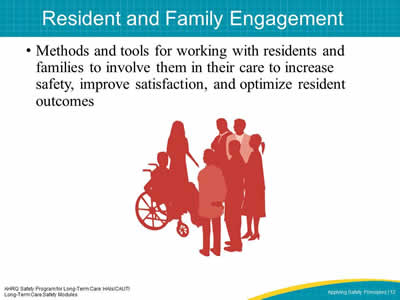
- Methods and tools for working with residents and families to involve them in their care to increase safety, improve satisfaction, and optimize resident outcomes.
Image: A group of people with a resident in a wheelchair.
Slide 13: Sustainability
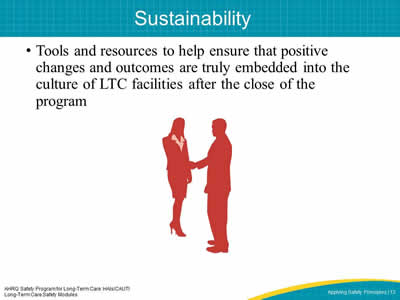
- Tools and resources to help ensure that positive changes and outcomes are truly embedded into the culture of LTC facilities after the close of the program.
Image: Two people shaking hands.
Slide 14: Implementation

- Share videos with teams to spark engagement in staff safety assessments.
- Provide templates and discussion guides to project leads.
- Educate teams on T.E.A.M.S. and Just Culture.
- Use videos and training modules to orient new staff.
- Train teams in using teamwork and communication tools.
- Engage senior leaders and project champions.
Slide 15: Challenges
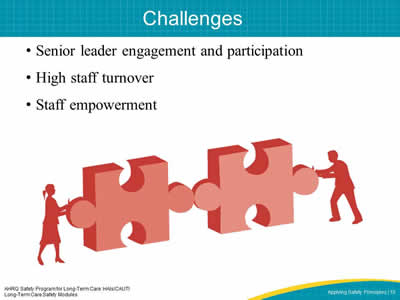
- Senior leader engagement and participation.
- High staff turnover.
- Staff empowerment.
Image: 2 people trying to push together 2 puzzle pieces that don't fit together.
Slide 16: Implementing Change Successfully

- Kotter's Eight Steps of Change2
Step 1:
Step 2:
Step 3:
Step 4:
Step 5:
Step 6:
Step 7:
Step 8:Create a sense of urgency
Create a guiding coalition
Develop a shared vision
Communicate the vision
Empower others to act
Generate short-term wins
Consolidate gains and produce more change
Anchor new approaches in culture - Just Culture principles.
Slide 17: Understanding Just Culture1
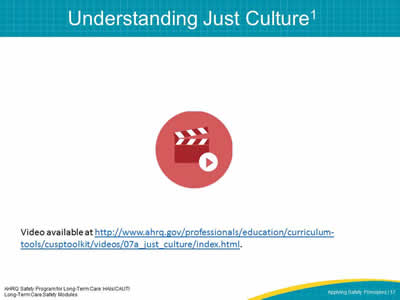
Image: Click the video icon to view the video
Video available at Understand Just Culture.
1. Griffith S. Just Culture, Healthcare Services Overview. Outcome Engineering; 2012.
Slide 18: Understanding Risk and Human Behavior1
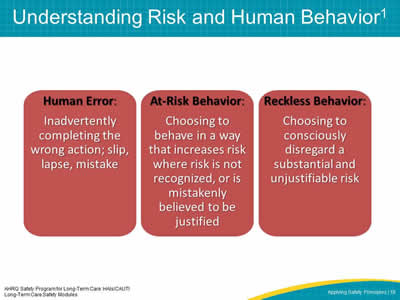
- Human Error:
Inadvertently completing the wrong action; slip, lapse, mistake. - At-Risk Behavior:
Choosing to behave in a way that increases risk where risk is not recognized, or is mistakenly believed to be justified. - Reckless Behavior:
Choosing to consciously disregard a substantial and unjustifiable risk.
1. Griffith S. Just Culture, Healthcare Services Overview. Outcome Engineering; 2012.
Slide 19: Managing Error and Risk1

|
Human Error |
At-Risk Behavior |
Reckless Behavior |
|---|---|---|
|
Product of our current system design and behavioral choices Manage through changes in:
|
A choice: risk believed insignificant or justified Manage through:
|
Conscious disregard of substantial and unjustifiable risk Manage through:
|
|
Console |
Coach |
Punish |
1. Griffith S. Just Culture, Healthcare Services Overview. Outcome Engineering; 2012.
Slide 20: Leadership's Role in Just Culture
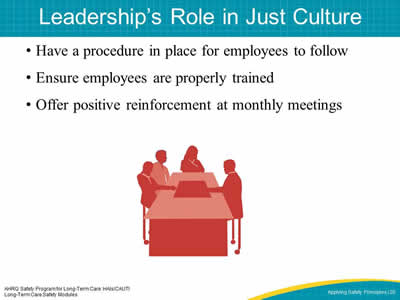
- Have a procedure in place for employees to follow.
- Ensure employees are properly trained.
- Offer positive reinforcement at monthly meetings.
Image: Group of people sitting around a table
Slide 21: Why Do We Do This Work?
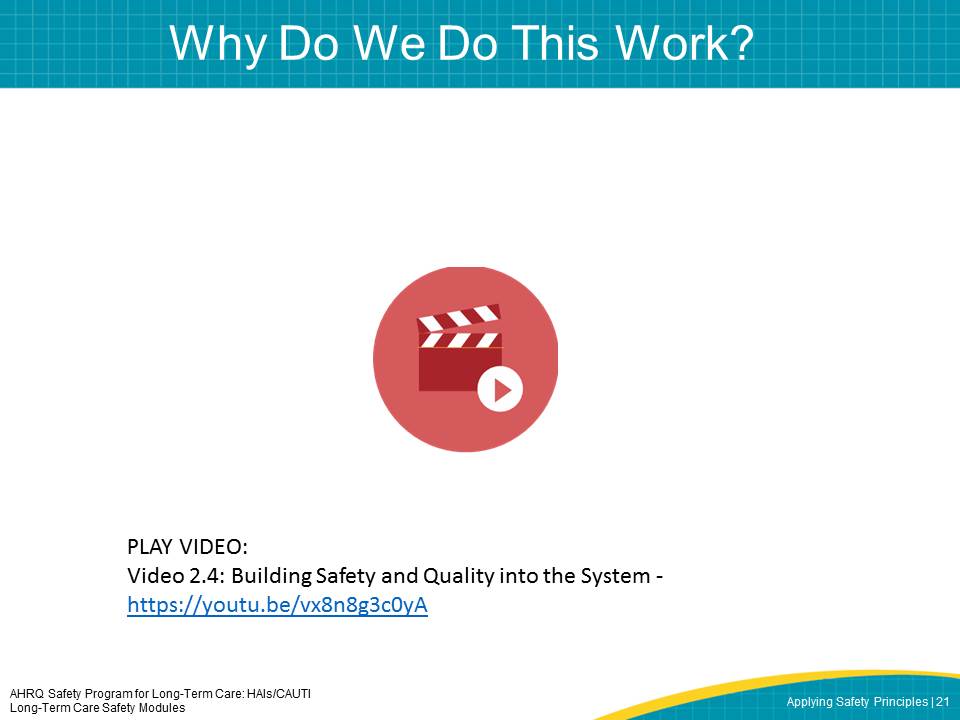
Image: Click the video icon to view the video.
PLAY VIDEO:
Video 2.4: Building Safety and Quality into the System
Slide 22: Long-Term Care Safety Tools and Resources
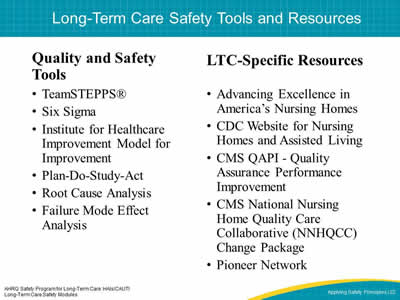
Quality and Safety Tools
- TeamSTEPPS®
- Six Sigma.
- Institute for Healthcare Improvement Model for Improvement.
- Plan-Do-Study-Act.
- Root Cause Analysis.
- Failure Mode Effect Analysis.
LTC-Specific Resources
- Advancing Excellence in America's Nursing Homes.
- CDC Website for Nursing Homes and Assisted Living.
- CMS QAPI - Quality Assurance Performance Improvement.
- CMS National Nursing Home Quality Care Collaborative (NNHQCC) Change Package.
- Pioneer Network
Slide 23: References
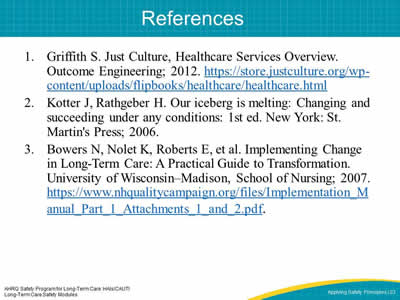
- Griffith S. Just Culture, Healthcare Services Overview. Outcome Engineering; 2012.
- Kotter J, Rathgeber H. Our iceberg is melting: Changing and succeeding under any conditions: 1st ed. New York: St. Martin's Press; 2006.
- Bowers N, Nolet K, Roberts E, et al. Implementing Change in Long-Term Care: A Practical Guide to Transformation. University of Wisconsin–Madison, School of Nursing; 2007.



